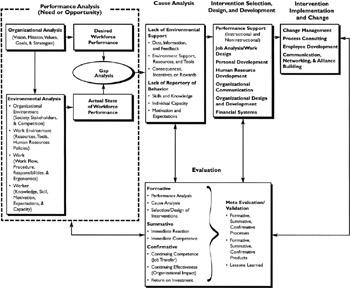Chapter 1: Fundamentals of Performance Technology - A Guide to Improving People, Process, and Performance
Performance Technology ”Defined
Too many phones are ringing to be answered promptly. Parts are being produced with flaws. Customers just won't buy the latest product improvement. Advertisements aren't catching shoppers' attention. Every workplace has challenges that seem unsolvable . Workers and managers have held meetings, written plans, and pledged new energy and resolve. Sometimes the new ideas work, sometimes nothing changes or matters get worse . It often seems difficult to control the workplace situation systematically. Why do the problems persist? Why do workers seem resistant to new ideas? Why do managers seem so "bossy" and insensitive?
Humans have tried to understand why people do what they do since the beginning of recorded history. Performance technology (PT) attempts to explain the observable aspects of workplace behavior, individually and collectively (such as through culture). However, PT does not pretend to be able to explain human behavior in its entirety; heredity, prior experiences, and other factors probably have an unbelievably great impact on any workplace situation.
Performance Technology ”Defined
Performance technology (PT) is the systematic process of linking business goals and strategies with the workforce responsible for achieving the goals. PT practitioners use a common methodology to understand, inspire , and improve people; they study and redesign processes leading to increased performance in the workplace. PT systematically analyzes performance problems and their underlying causes and describes exemplary performance and success indicators.
PT attempts to:
-
Analyze observable workplace behavior.
-
Associate the behaviors with related environmental factors, such as organizational culture and mission.
-
Determine the causes of exemplary and problem behaviors.
-
Design possible solutions, called interventions.
-
Put the interventions into action.
-
Monitor and measure the results to document the effectiveness of the intervention toward designed change.
The Human Performance Technology (HPT) Model
The previous list may seem like the established standard used to understand human situations and make changes. In fact, the traditional approach to problem solving usually deals with groups or departments and focuses on a single defined concern. For example, reengineering usually focuses on a particular process or job design as an approach to improve productivity. In this situation, little attention is given to how performances are recognized and rewarded. The traditional approach fails to link employee behavior with organizational culture and to deal with the full complexity of work behavior.
In contrast, the HPT Model (Figure 1-1) acknowledges the complexity of the workplace and the interrelationships among all organizational factors. Careful analysis of multiple factors helps the PT practitioner to more accurately diagnose human behavior and its impact on the organization and vice versa. Finally, measuring the results of PT activities allows the PT practitioner to modify interventions and to verify success. In other words, each stage of the HPT Model helps practitioners understand why people do what they do.

Figure 1-1: HUMAN PERFORMANCE TECHNOLOGY (HPT) MODEL
Because human behavior is influenced by the reciprocal patterns of the workplace culture and individual factors, PT practitioners consider all of these factors simultaneously . Subsequently, an array of interventions are identified as potential solutions. The HPT Model also challenges upper management to create an environment that fosters success.
Book Structure
Fundamentals of Performance Technology: A Guide to Improving People, Process, and Performance describes each major category and component of the HPT Model in a practical, how-to manner. Using a handbook format, this book is designed to make the theory understandable and action-oriented . It offers commonsense interventions for improving workplace human behavior. Each chapter contains a description of one component of the HPT Model, followed by a case study to illustrate the component, and a job aid. The reader will finish the book energized by the belief: "Yes, I can do that!"
Readers new to the field may not be familiar with job aids. They are officially known as performance support tools; they provide highly organized information needed to support desired action. They may be paper-based, computer-based, cardboard, laminated, or spiral bound. They are intended to be convenient , easy-to-grab, easy-to-skim, easy-to-follow. According to Elsenheimer, job aids are well-suited for tasks with the following characteristics: [1]
-
Low frequency ”seldom happens, no need to memorize task
-
High complexity ” unrealistic to learn multitask steps, especially when in a particular order
-
Frequently changing ”quick updates are possible because people rely on the latest information
-
Low budget ”simple to develop and update in the beginning or as information changes
-
High consequence of errors ”used as a reminder to minimize errors
[1] Elsenheimer, October 1998
EAN: 2147483647
Pages: 98